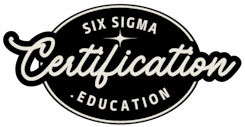Best Six Sigma Book – 2025 Update
Why “Navigating Lean Six Sigma” is Our 2025 Pick
"Navigating Lean Six Sigma: A Comprehensive Guide for Black Belts" serves as the definitive companion for professionals pursuing Lean Six Sigma Black Belt certification through MSI. This book consolidates the vast expanse of Lean Six Sigma methodologies, tools, and best practices into a clear, structured, and digestible format - perfect for candidates preparing for the MSI certification exam or working professionals applying Six Sigma in real-world projects.
What truly makes it stand out is its practical, industry-spanning approach. Rather than focusing solely on theory, it blends key concepts with simulated case studies, demonstrating how Lean Six Sigma applies across diverse sectors - from manufacturing and logistics to healthcare and service industries.
Readers will find step-by-step guidance through core Black Belt topics like DMAIC, statistical analysis, root cause identification, process capability, and leadership of cross-functional improvement projects. Each chapter reinforces the mindset of continuous improvement while emphasizing practical implementation and measurable business impact.
In short, Navigating Lean Six Sigma is more than just a certification study guide - it's a career companion for anyone serious about mastering process improvement and leading organizational excellence. Purchasing this book isn't just an investment in certification; it's an investment in a proven methodology that can transform how you think, lead, and improve results.
What truly makes it stand out is its practical, industry-spanning approach. Rather than focusing solely on theory, it blends key concepts with simulated case studies, demonstrating how Lean Six Sigma applies across diverse sectors - from manufacturing and logistics to healthcare and service industries.
Readers will find step-by-step guidance through core Black Belt topics like DMAIC, statistical analysis, root cause identification, process capability, and leadership of cross-functional improvement projects. Each chapter reinforces the mindset of continuous improvement while emphasizing practical implementation and measurable business impact.
In short, Navigating Lean Six Sigma is more than just a certification study guide - it's a career companion for anyone serious about mastering process improvement and leading organizational excellence. Purchasing this book isn't just an investment in certification; it's an investment in a proven methodology that can transform how you think, lead, and improve results.

